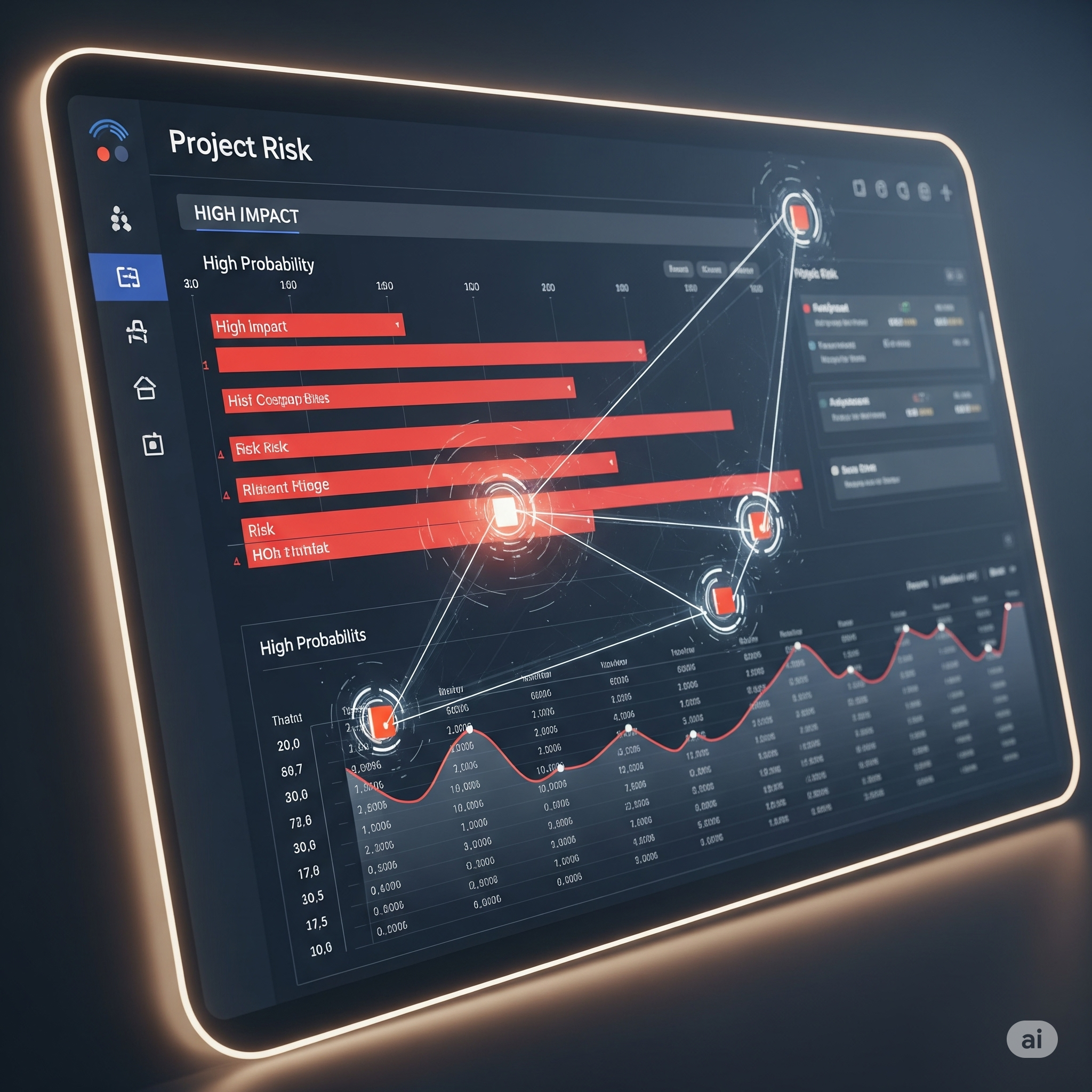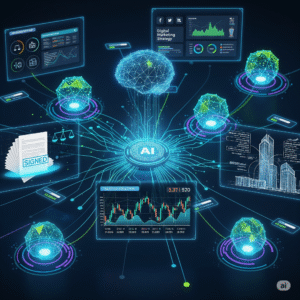There’s a timeless saying in project management: “The best-laid plans of mice and men often go awry.” Every seasoned project manager knows this feeling. You can spend weeks crafting the perfect project plan, complete with detailed schedules and resource allocation, only to have an unforeseen issue derail everything. For decades, risk management has been a largely manual and intuitive process, relying on brainstorming sessions, static spreadsheets, and the hard-won “gut feelings” of experienced leaders. While valuable, this approach is fundamentally reactive. You can only plan for the risks you can imagine.
But what if you could see around the corners? What if you could tap into a system that could identify potential roadblocks you haven’t even considered? This is the promise of a powerful technological shift that is revolutionizing project planning. The integration of AI project risk prediction is transforming risk management from a guessing game into a data-driven science. It’s about empowering teams not just to react to problems, but to proactively anticipate and neutralize them before they ever materialize. This article explores how this technology works, the tangible impact it’s having, and how you can begin leveraging it to build more resilient, successful projects.
What is AI Project Risk Prediction and Why Does It Matter?
At its heart, AI project risk prediction is the application of machine learning (ML) models and advanced analytics to forecast potential risks within a project. Instead of relying solely on human experience, this approach ingests massive amounts of data—from past projects, real-time progress reports, team communications, and even external market factors—to identify patterns and correlations that are invisible to the human eye. The AI learns what combinations of factors have historically led to budget overruns, schedule delays, scope creep, or quality issues.
This represents a monumental leap from traditional risk registers. A static risk log is a snapshot in time, often created at the project’s outset and only updated periodically. AI project risk prediction, on the other hand, is a dynamic, living system. It continuously monitors the project ecosystem, updating risk probabilities in real-time as new data becomes available. This shift is crucial because it moves the entire practice of project management from a defensive, reactive posture to an offensive, proactive one. It’s about replacing “I think this might be a problem” with “There is an 85% statistical probability of a budget overrun in Phase 3 if we don’t reallocate resources now.”
The Core Mechanisms Behind Effective AI Project Risk Prediction
The “magic” of AI project risk prediction isn’t magic at all; it’s a combination of sophisticated data analysis techniques working in concert. Understanding these mechanisms helps demystify the process and reveals how actionable insights are generated. The system’s power comes from its ability to process diverse data types through multiple analytical lenses.
Learning from the Past: Leveraging Historical Data with AI
The foundation of any good prediction model is historical data. An AI system can analyze every completed project in your organization’s history—both the successes and the failures. It scrutinizes timelines, task dependencies, team compositions, communication logs, and final outcomes. By doing so, it uncovers subtle, non-obvious patterns. For example, it might discover that projects involving a specific combination of third-party software and junior developers have historically run 30% over budget. This insight, derived from data, becomes a powerful leading indicator for future AI project risk prediction.
Real-Time Monitoring for Dynamic Risk Assessment
A project is a living entity, and its risk profile changes daily. A robust Project planning AI system integrates with your live project management tools (like Asana, Jira, or Trello) and other data streams. It monitors task completion rates, identifies bottlenecks as they form, and tracks resource availability. If a critical path task is falling behind schedule by just a few hours, the AI can immediately calculate the cascading impact on the final deadline and flag it as an escalating risk. This real-time vigilance ensures that managers are always working with the most current risk landscape, not one from last week’s status meeting.
Real-World Impact: Case Studies in AI Project Risk Prediction
The tangible benefits of AI project risk prediction are being realized by innovative companies across the globe. These organizations are turning data into a strategic asset, creating a significant competitive advantage through superior project planning and execution.
Case Study 1: “Innovatech Solutions” and Mitigating Technical Debt
A fast-growing software company, “Innovatech Solutions,” was plagued by a common problem: their rapid development cycles were creating unforeseen technical debt. This led to buggy releases and delayed feature launches as teams had to circle back for extensive refactoring. They implemented an AI tool that analyzed their code repository, developer comments, and task dependencies within Jira. This Project planning AI was trained to identify early signs of high-risk code modules.
The AI system started flagging code segments with unusually high complexity, a high rate of revisions, and negative sentiment in developer comments (e.g., “hack,” “workaround,” “temporary fix”). This provided an early warning system for technical debt. The AI project risk prediction model correctly identified over 75% of the modules that would later cause major bugs, giving the engineering leads a chance to address the issues proactively during development sprints. This led to a 20% reduction in critical bugs found post-release and a significant improvement in on-time delivery.
Case Study 2: “Terra Firma Engineering” and Supply Chain Resilience
For a major civil engineering firm like “Terra Firma,” supply chain volatility is a multi-million-dollar risk. A delayed shipment of custom steel beams or specialized equipment can halt construction for weeks. They adopted a sophisticated AI risk platform that used natural language processing to monitor global news, financial reports, and shipping logistics data, integrating it with their own supplier information. This approach aligns with guidance from the Project Management Institute (PMI), which highlights AI’s role in managing complex project variables.
The system’s AI project risk prediction capabilities paid off almost immediately. It flagged a secondary supplier’s parent company for financial instability based on international news reports—weeks before any official announcement. This gave “Terra Firma” enough time to vet and secure an alternative supplier, completely avoiding a disruption that would have delayed a critical bridge project by an estimated two months. The platform continuously scans for risks, from port strikes and weather events to geopolitical tensions, providing the firm with unprecedented foresight.
Top Tools for AI Project Risk Prediction and Planning
Implementing AI doesn’t mean you need a team of data scientists. A growing number of accessible tools can help you integrate predictive capabilities into your existing workflows.
- ChatGPT & Generative AI: Tools like OpenAI’s ChatGPT are excellent for qualitative risk brainstorming. You can run a “project pre-mortem” by feeding it your project plan and asking, “Acting as an expert risk analyst, what are the top 10 potential risks for this project and their likely causes?”
- Power BI & Tableau: These powerful business intelligence tools are essential for visualizing risk. You can connect Microsoft Power BI to your project data to create interactive risk dashboards that highlight hotspots and trends, making complex data easy to understand.
- MonkeyLearn: A tool like MonkeyLearn specializes in text analysis. It can be used to analyze customer feedback, internal team communications, or survey responses to detect sentiment and identify emerging issues before they become formal risks.
- Specialized Predictive Platforms: For industries like construction and engineering, dedicated platforms like nPlan or Alice Technologies offer advanced AI project risk prediction by simulating thousands of project scenarios to find the optimal path and identify hidden risks.
A Beginner’s Workflow for Implementing AI Project Risk Prediction
Embarking on your AI project risk prediction journey can be straightforward if you take a methodical, step-by-step approach.
- Consolidate Your Data: AI thrives on data. The first step is to gather and centralize information from past projects. This includes schedules, budgets, risk logs, post-mortem reports, and team feedback. The more comprehensive your historical data, the more accurate the predictions will be.
- Start with a Specific Risk Category: Don’t try to predict everything at once. Focus on a single, high-impact area where you have good data. This could be “budget overruns” or “schedule delays on development tasks.”
- Leverage Accessible Tools for a Quick Win: Use a tool like ChatGPT for an initial analysis. This qualitative approach helps frame your thinking and identify obvious risks you might have missed. It’s a key first step in building your Project planning AI strategy.
- Visualize for Clarity: Connect your data to a BI tool like Tableau or Power BI. Create a simple dashboard that tracks the key metrics related to the risk you’re focusing on. Visualizing the data often reveals patterns you wouldn’t see in a spreadsheet.
- Review, Discuss, and Refine: Remember, AI provides insights, not orders. Use the predictions as a starting point for a strategic discussion with your team. The combination of AI-driven data and human experience is where the true power lies. As noted in business insights from sources like HubSpot, this collaborative approach is key to successful AI implementation.
The Future of Project Planning AI: From Prediction to Prescription
The field of AI project risk prediction is rapidly evolving. The next frontier is moving beyond simply predicting a risk to actively prescribing the best possible solution. Future AI systems won’t just tell you a project has a 70% chance of delay; they will run thousands of simulations to recommend the optimal course of action—whether it’s reassigning a specific developer, ordering materials from an alternate vendor, or adjusting the project timeline.
This leads to the concept of a “digital twin” for your project—a complete virtual model that allows you to test scenarios and stress-test your plan against any number of variables before committing resources in the real world. The project manager’s role will shift further towards that of a strategist, using these powerful AI-driven insights to make smarter, faster, and more confident decisions, ensuring the human element of leadership and judgment remains central to success.
Conclusion: Build Your Most Resilient Plan Yet
In an increasingly complex world, leaving project success to chance is no longer a viable strategy. AI project risk prediction offers a clear path towards building more robust, resilient, and successful project plans. By harnessing the power of data, you can move from fearing the unknown to strategically preparing for it. The tools and techniques are more accessible than ever, enabling teams of all sizes to enhance their Project planning AI capabilities.
Your journey starts with a single step. Look at your current project. What is the one risk that keeps you up at night? Begin there. Gather the data, ask the right questions, and explore how a simple AI-driven insight could transform your approach. By embracing this new paradigm, you’re not just managing a project; you’re engineering its success from day one.
Personalizing Employee Experience with AI: From Onboarding to Retention
AI Performance Management: Revolutionizing Performance Reviews



